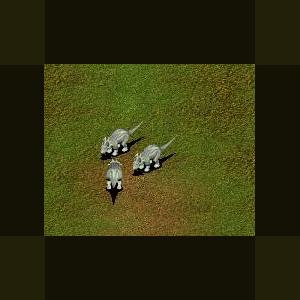About This File
Pachyrhinosaurus
Pachyrhinosaurus (meaning "thick-nosed reptile") is a genus of ceratopsid dinosaur from the Late Cretaceous period of North America. The first examples were discovered by Charles M. Sternberg in Alberta, Canada, in 1946, and named in 1950. Twelve partial skulls and a large assortment of fossils have been found in total in Alberta and Alaska. A great number were not available for study until the 1980s, resulting in a relatively recent increase of interest in the Pachyrhinosaurus. Instead of horns, the skull bears massive, flattened bosses, the largest being over the nose. These were probably used in butting and shoving matches, as in musk oxen. A single pair of horns grew from the frill and extended upwards. It appears that that both the shape and size of the frill was highly individualized, reliant on gender and perhaps other factors. Pachyrhinosaurus is most closely related to Achelousaurus.
Pachyrhinosaurus was 5.5 to 7 meters (18 to 23 ft) long. It weighed about four tons. It was herbivorous and possessed strong cheek teeth to help it chew tough, fibrous plants.
The type species, Pachyrhinosaurus canadensis, was described in 1950 by Charles Mortram Sternberg.
In 1972, Grande Prairie, Alberta science teacher Al Lakusta found a large bonebed along Pipestone Creek in Alberta. When the area was finally excavated between 1986 and 1989 by staff and volunteers of the Royal Tyrrell Museum of Palaeontology, paleontologists discovered an amazingly large and dense selection of bones--up to 100 per square meter, with a total of 3500 bones and 14 skulls. This was apparently the site of a mass mortality, perhaps a failed attempt to cross the river during a flood. Found amongst the fossils were the skeletons of four distinct age groups ranging from juveniles to full grown dinosaurs, indicating that the Pachyrhinosaurus did indeed care for their young.
The adult skulls had both convex and concave bosses as well as unicorn-style horns on the parietal bone just behind their eyes. The concave boss types might be related to erosion only and not reflect male/female differences. In 2008, a detailed monograph describing the skull of the Pipestone Creek pachyrhinosaur, and penned by Philip J. Currie, Wann Langston, Jr., and Darren Tanke, classified the specimen as a second species of Pachyrhinosaurus, named P. lakustai after its discoverer



Recommended Comments
There are no comments to display.
Create an account or sign in to comment
You need to be a member in order to leave a comment
Create an account
Sign up for a new account in our community. It's easy!
Register a new accountSign in
Already have an account? Sign in here.
Sign In Now